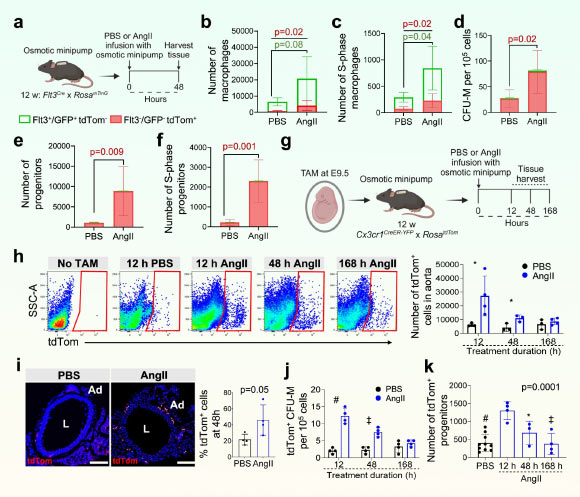
Dubbed EndoMac progenitors, the newly-discovered type of cell has the potential to enhance the future of tissue repair and generation, according to a team of scientists headed by South Australian Health and Medical Research Institute researchers.

Angiotensin II-induced vascular inflammation involves early expansion of EndoMac progenitors in vivo. Image credit: Williamson et al., doi: 10.1038/s41467-024-51637-7.
“The EndoMac progenitor cells possess the unique ability to transform into two specific cell types of cells: endothelial cells that form blood vessels, and macrophages that are immune cells responsible for tissue repair and defense,” said Dr. Sanuri Liyange, a researcher at the South Australian Health and Medical Research Institute and the University of Adelaide.
“These cells have an important job, to help grow blood vessels when the body calls for it.”
“They are activated by injury or poor blood flow, at which point they rapidly expand to aid in healing.”
“Cells with similar functions have been theorized to exist for more than a century however, until now, had never been found.”
“They were discovered in the outer layer of aortas in adult mice.”
According to the team, the EndoMac progenitors could be used to boost healing in conditions like diabetes, where the body struggles to repair itself properly.
Crucially, these cells don’t express typical ‘self’ markers, meaning they could be ideal candidates for stem cell transplantation as they’re much less likely to be attacked by the recipient’s immune system.
Dr. Liyange and colleagues isolated the cells from mice, grown them and observed them forming colonies.
These colonies were tested in diabetic mouse models, showing remarkable improvements in wounds that normally wouldn’t heal.
“When we transplanted these progenitors into diabetic wounds, we saw a dramatic improvement in healing within days,” Dr. Liyange said.
“In theory, this could become a game-changer for patients suffering from chronic wounds.”
The authors are currently working on similar studies involving skin and muscle cells, with findings expected to be delivered in the next 12 months.
They’re also searching for the cells in human tissue with promising indications.
“We’re excited to continue exploring the potential of these cells. It’s early days, but the implications could be massive,” Dr. Liyanage said.
“This represents a significant advancement in our understanding of blood vessel regeneration and holds promise for creating more effective treatments that support the body’s capacity to heal and maintain function over time.”
A paper on the findings was published in the journal Nature Communications.
_____
A.E. Williamson et al. 2024. Discovery of an embryonically derived bipotent population of endothelial-macrophage progenitor cells in postnatal aorta. Nat Commun 15, 7097; doi: 10.1038/s41467-024-51637-7
 Print
Print


